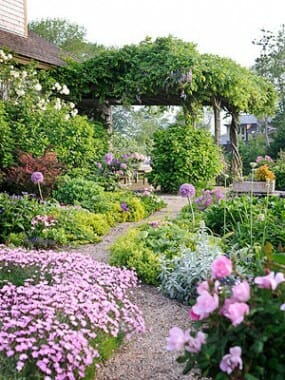Often times we are asked by clients about how to best use small spaces and create beautiful lively gardens on a budget. The following article focuses on one of our favorite ways to achieve just that by creating a living wall garden. The best thing is they are easy to make, require little maintenance and are completely weed free. The following article is by Shawna Coronado who is an authority on the subject of live wall gardening ideas. We hope you enjoy the read…
 Living wall systems can be quite money-saving. You can use the systems year after year and can be planted with seeds or a combination of seeds and pre-grown Grow a Living Wall Book by Shawna Coronado plants in order to reduce expenses. While the garden featured here is a flower garden with orange and cream “dreamsicle” color combinations, now is the perfect time to consider planted fall and winter vegetables and other fall blooming annuals – a living wall is the perfect place to plant all season long. Whether you are doing a fall garden or planning next springs planting, below is an excerpt from my latest book giving you money saving garden ideas on how to grow a living wall garden – Grow a Living Wall; Create Vertical Gardens with Purpose. And remember – all these living wall gardens are WEED FREE. No weeds at all!
Living wall systems can be quite money-saving. You can use the systems year after year and can be planted with seeds or a combination of seeds and pre-grown Grow a Living Wall Book by Shawna Coronado plants in order to reduce expenses. While the garden featured here is a flower garden with orange and cream “dreamsicle” color combinations, now is the perfect time to consider planted fall and winter vegetables and other fall blooming annuals – a living wall is the perfect place to plant all season long. Whether you are doing a fall garden or planning next springs planting, below is an excerpt from my latest book giving you money saving garden ideas on how to grow a living wall garden – Grow a Living Wall; Create Vertical Gardens with Purpose. And remember – all these living wall gardens are WEED FREE. No weeds at all!
Watching my grandmothers garden their plots was perhaps the best way to learn how to be frugal. They reused everything: coffee tins were saved to hold and sort seeds and tools, tomato stakes were old broom sticks, watering cans were old buckets, pie tins were tied to stakes in the garden to keep away pests, compost tea was handmade from old sheep dung, and pantyhose cut up into strips was used to tie up bean plants. There was no waste in those gardens. Dead plantings and rotted vegetables Living Wall with Sweet Potato Vine and Zinnia Photo © copyrightwere used to make compost, and no potting soil was ever needed as soil from the old sheep barn was filled with more healthy microbes than any manufactured soil. They planted everything from seed—it was a money-saving garden.
There are several easy-to-grow flowers and vegetables that are simple to sow directly in the soil of the living wall container. Start by working your preferred organic fertilizer or soil amendments into your soil. Add the soil to the living wall system, then gently water. This helps the seeds to stick to the soil where you place them. Plant the seeds according to the directions on the seed package—some seeds require light to germinate and must be placed at the top of the soil, and some seeds require a deeper planting. If you have enough space and want a straight planting row, use a garden row marker tool to make it straight. The [Le Jardinet Garden Dibber] tool allows you to stretch out string between two garden dibbers to dig a small furrow that helps guide seed planting along the straight line. Whether you choose planting rows or more clustered planting in a living wall pocket is really based on what your final design goal might be.
Generally speaking, seed placement can be important for a living wall; plants that hang over and grow lush should be planted at the front edge of the planting pocket so the plant can spill over the edge. Fuller, medium-sized plants do well in the middle of the planting pocket and function as a filler for the center of the planting area. Tall plants should be placed at the back of the pocket so that their height can peek out from behind the other plants and also cover some of the blank wall behind the system.
